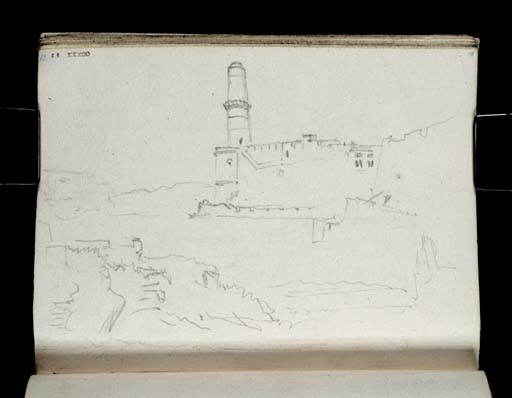Joseph Mallord William Turner The Tour du Fanal and Fort Saint-Jean, Marseille 1828
Image 1 of 2
Joseph Mallord William Turner,
The Tour du Fanal and Fort Saint-Jean, Marseille
1828
Folio 53 Recto:
The Tour du Fanal and Fort Saint-Jean, Marseille 1828
D21092
Turner Bequest CCXXX 52
Turner Bequest CCXXX 52
Pencil on cream lined wove paper, 111 x 145 mm
Inscribed in blue ink by John Ruskin ‘52’ top left, ascending vertically, and ‘4’ top right, ascending vertically
Stamped in black ink ‘CCXXX 52’ top left, upside down
Inscribed in blue ink by John Ruskin ‘52’ top left, ascending vertically, and ‘4’ top right, ascending vertically
Stamped in black ink ‘CCXXX 52’ top left, upside down
Accepted by the nation as part of the Turner Bequest 1856
References
1909
A.J. Finberg, A Complete Inventory of the Drawings of the Turner Bequest, London 1909, vol.II, p.707, CCXXX 52, as ‘River, with steep walls and tower. Probably at Marseilles.’.
1974
Martin Butlin, Andrew Wilton and John Gage, Turner 1775–1851, exhibition catalogue, Royal Academy, London 1974, p.115 under no.377.
1981
Maurice Guillaud, Nicholas Alfrey, Andrew Wilton and others, Turner en France: aquarelles, peintures, dessins, gravures, carnets de croquis / Turner in France: Watercolours, Paintings, Drawings, Engravings, Sketchbooks, exhibition catalogue, Centre Culturel du Marais, Paris 1981, p.276, fig.520, as ‘Lightower at Marseilles.’.
1975
Andrew Wilton, Turner in the British Museum: Drawings and Watercolours, exhibition catalogue, Department of Prints and Drawings, British Museum, London 1975, p.97 under no.149.
Turner likely reached Marseille in early September 1828, and apparently spent several days sketching the old port and its surrounding fortifications. Besides sketching, he also found time for a swim, a means of coping with the intense heat: as he later recalled in a letter to his friend the artist George Jones, ‘until I got a plunge into the sea at Marseilles, I felt so weak that nothing but the change of scene kept me onwards to my distant point.’1 As noted by the geographer and Turner researcher Roland Courtot, this sketchbook shows Turner’s fascination with the port area, the city’s economic hub, shown here as a hive of activity.2 During this time, the port was recovering from the disruption to maritime trade resulting from the Continental blockade during the Napoleonic era. Turner also studied the city’s seventeenth-century fortifications surrounding the port, and particularly the distinctive domed tower of the Tour du Fanal, visibly in many of the following sketches. In total, twenty-seven pages record Turner’s impressions of Marseille, making it the most comprehensively examined location in the entire sketchbook. See folios 46 verso, 49 recto, 53 recto–64 recto, and 65 verso–66 recto (D21079, D21084, D21092–D21114, D21117–D21118; Turner Bequest CCXXX 45a, 48, 52–63 and 64a–65).
Turner’s vantage point here is from the south side of the port, near Fort Saint-Nicolas. Looking north across the water, he outlined with precision the cylindrical domed structure of the Tour du Fanal, a seventeenth-century watchtower built to guide merchant ships. As Courtot pointed out, it is possible that Turner was already familiar with this view from Joseph Vernet’s L’Entrée du port de Marseille, 1754 (Musée du Louvre, Paris), which was engraved and circulated in London in the 1760s.3
Hannah Kaspar
March 2024
Roland Courtot, ‘6. Le carnet du voyage de Turner de Lyon à Marseille (CCXXX)(3)’, Carnets de voyage de Turner, accessed 29 January 2024, https://carnetswt.hypotheses.org/528 .
How to cite
Hannah Kaspar, ‘The Tour du Fanal and Fort Saint-Jean, Marseille 1828’, catalogue entry, March 2024, in David Blayney Brown (ed.), J.M.W. Turner: Sketchbooks, Drawings and Watercolours, Tate Research Publication, February 2025, https://www


